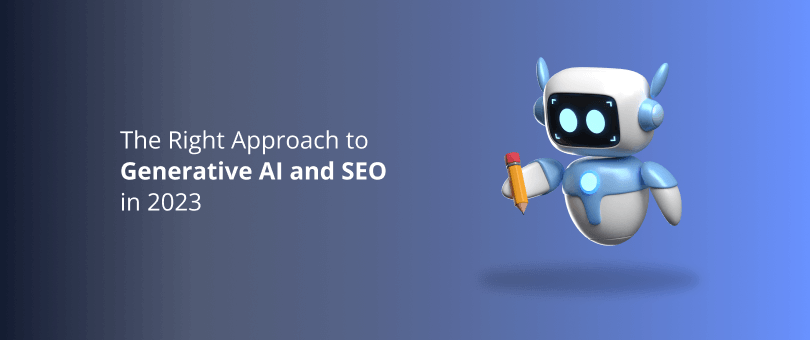Content creators are always aiming to step up their game by producing high-quality content at scale.
In response to their needs, there has been a substantial surge in the use of one particularly intriguing application of artificial intelligence – Generative AI. This wizard can create unique content by following human instructions.
As Generative AI goes mainstream, legitimate questions are surfacing. What approach should professional content creators have toward it and how can they use its power to boost their own creative potential instead of replacing it?
At the beginning of 2023 Google stated that they are rewarding high-quality content no matter how it is produced. Their ranking systems aim to support content that demonstrates expertise, experience, authoritativeness, and trustworthiness (E-E-A-T). This means Google accepted the inevitability of the use of AI in content creation and set up the criteria creators should follow if they want their content to be ranked high.
This article shares best practices for a humans-first approach when using generative AI and SEO. With the right strategy, AI-powered content can scale without compromising quality or SEO. Keep reading to learn more.
Readers Also Enjoy: What Is Semantic AI: Importance, Applications, Benefits – DevriX
What Is Generative AI?
Generative AI refers to next-gen models that can generate content from scratch – text, images, audio, video. Think GPT-3 writing original essays, DALL-E conjuring up surreal images, and deep fakes cloning voices and faces.
Realistically, you can use AI tools to create content, reducing the need for human writers, photographers, or illustrators. The question is whether the content is good enough or not.
AI-generated content is decent, and many companies are producing it. But it has its drawbacks, such as repetitive and bland AI content. After a while of producing AI copies of copies of copies, human-generated content stands out as more original, authoritative, and readable. This is what Google wants (E-E-A-T).
Another big drawback is that AI-generated content serves algorithms rather than readers, especially when using it for SEO tactics only. As a result, the text and images may not be as useful to readers.
What Is AI-powered SEO?
AI-powered SEO utilizes AI tools such as Google’s BERT and RankBrainto analyze keywords and website performance, determining optimal steps to improve search rankings. With 90% of organizations prioritizing SEO in 2023, leveraging AI for SEO is becoming more and more important.
There are many useful AI-powered SEO tools such as:
- Jasper AI. Jasper writes high-quality blog posts and social media captions in seconds.
- Moz. It analyzes sites and suggests keyword opportunities.
- Semrush. AI that evaluates pages and recommends improvements for higher rankings.
- Clearscope. It assesses content and identifies issues to address.
- SerpRobot. Crawls sites to check for technical SEO errors.
With these and other emerging AI technologies, marketers can scale content production, identify growth areas, diagnose site problems, and boost their SEO speed and efficiency. AI delivers the data-driven insights and content needed to improve rankings and stay ahead in competitive search landscapes.
How to Choose the Right Generative AI?
With the rapid advancement of generative AI, it is easy to be confused by the sea of options when choosing the right AI buddy for your content creation needs.
When examining your options, start by looking at:
- Intended Use Case. What will you use the AI for? Some excellent options include:
– Content generation (Jasper, Anthropic, Copy.ai, CCha)
– Code generation (GitHub Copilot, TabNine)
– Image generation (DALL-E, Midjourney) - Output Quality. Reviews examples to evaluate coherence, creativity, and accuracy.
- Model Capabilities. Considers the model size, architecture, training data, and other capabilities.
- User Interface. Looks for an intuitive UI that makes it easy to guide the AI.
- Customization. How much do you have to tweak to tailor the output?
- Ethical Considerations. Ensures responsible AI practices around bias and content safety.
- Scalability. Can the AI grow with your needs?
- Cost. Factors in the pricing models and any other costs at scale.
Readers Also Enjoy: 3 AI Writing Assistants That Can Help You Write Compelling Copy – DevriX
A Human-Centered Approach to Utilizing Generative AI and SEO
The question is not whether you have to use generative AI, but how to use it effectively. Remember, the main objective is to generate original and useful content, optimized for search engines. This means to strike a balance between automation and originality. Here is how to do it:
Focus On Quality
With AI algorithms working tirelessly, content creators can generate a large volume of content in a short time. Sounds great, right? It’s fast, it’s cheap. And at the end, you can simply provide a title or ask a question, then go have a cup of coffee, and the AI will produce an article for you.
However, such a strategy will most likely reduce the overall quality, as the quality of the result depends on the quality of the input (prompts) you provide.
Tips on How to Master Prompt Design
Prompt design is the process of carefully crafted instructions and/or context provided to the AI systems to elicit desired behaviors and responses.
A few key tips of effective prompt design include:
- Specify the role AI should take on and the tone it should use in its responses. This helps it understand how to frame its responses appropriately.
- Provide clear instructions and ask targeted questions rather than open-ended ones. This gives AI more specifics to work with.
- Establish the right level of context by providing the relevant information anddetails about the situation at hand. More context helps AI generate more pertinent, in-depth responses.
- Use examples to illustrate the type of response you’re looking for. This gives an AI template to follow.
- Set expectations. Provide examples of how to frame things like, “Respond in a helpful, friendly way” or “Provide a thoughtful analysis given the following scenario.” This guides AI overall approach.
- Check responses and refine the prompts over multiple interactions.
Learn Prompt Chaining
Instead of asking your AI buddy to write an entire article, use prompt chaining. Prompt chaining is a method that breaks the content creation into smaller tasks. This will result in better quality as the AI focuses on each task separately.
For example:
- Ask the AI to create an outline. Give it a list of headings and subheadings. This way you are helping it to organize its thoughts.
- Have it write the content of each subheading.
- Then ask it to rewrite everything. After the content is ready, ask it to rewrite it with your brand voice.
- Now format the content and its headings, bullet points, etc. Bold text, if necessary, for better readability.
Check, Edit and Refine
There are AI tools that can follow both your brand style and editorial criteria, and act as its own editor and further improve the content quality. Others can provide backlinks for statements made in the article. Furthermore, these options should be used if you aim for fully AI-generated content.
However, this is also the step where your human-focused approach to generative AI will make all the difference. Besides, there is no artificial intelligence that can substitute human creativity, originality and authenticity.
Train Your AI to Maintain Your Brand Voice and Style
Maintaining a consistent brand voice and style is crucial for establishing trust and familiarity with your audience. When working with generative AI you have to ensure it stays in line with your identity.
- Feed the AI plenty of examples of content written in the brand’s voice. This allows the AI to learn the tone, style, word choices, etc. that are characteristic of that brand. The more examples the better.
- Explicitly indicate the brand name when providing writing prompts to the AI. Making it clear which brand’s voice is expected will help the AI adopt the appropriate style.
- Correct the AI when it deviates from the brand’s voice. Providing feedback and additional examples helps reinforce the style the brand is supposed to be mimicking.
- Use tools like Stylemix that allow you to specify a particular style, like conversational or formal. Fine-tuning the AI model with texts of the desired style will make the output more precise.
Create Human-Centered SEO Strategy
The key to achieving effectiveness and lasting results is to put humans, not algorithms, at the heart of your SEO strategy.
A human-centered approach to SEO goes beyond just targeting keywords. To generate content that provides genuine value consider these tips:
- Keywords. Passing your targeted keywords onto your AI will help it to produce SEO optimized content that ranks high.
- Add customer data. Providing customer data such as demographics, preferences, behaviors, etc. will help the AI to generate targeted to your audience content.
- Scrape relatable data. Perform web searches and scrape data sources to include the latest information and statistics surrounding your content.
- Add internal documentation. Integrate your internal documentation (mission, vision, etc), this will allow AI to align the content with your brand voice and messaging.
- Optimize media. Include optimized images, videos, infographics etc. to improve engagement and dwell time. AI can then suggest media based on your content.
- Track analytics. Review site analytics to identify the content that resonates best with your audience and double down on those topics and styles. Adjust based on low-performing content.
Readers Also Enjoy: Keyword Mapping for SEO: The Ultimate Guide – DevriX
Wrap Up
As AI becomes more mainstream, it’s important not to lose the human touch. While generative AI provides efficiency and scale, the highest quality content comes from a blended approach.
Maintain quality through thoughtful prompts, editing, and refinement. Keep your brand’s voice consistent. And focus on creating content that genuinely serves people – that’s what will ultimately connect you with your audiences and satisfy search engines.

![Small Business SEO Top 7 Benefits [2023]](https://devrix.com/wp-content/uploads/2021/12/Small-Business-SEO_-Top-7-Benefits-2023-380x160.png)


